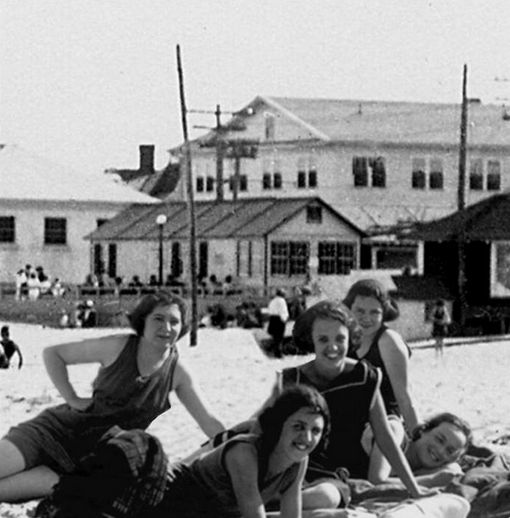History Matters
By Cheryl Lassiter
Hampton Union, April 8, 2016
[The following article is courtesy of the Hampton Union and Seacoast Online.]

Hampton Beach bathing beauties with a rear view of the Carnival Cottage. [Courtesy of the Hampton Historical Society.]
During the 39 years from 1915 to 1953, Carnival Week at the beach was a Labor Day holiday tradition. Created by the Hampton Beach Board of Trade to extend the summer season, it was a week-long exhibition of vaudeville, games, parades, fireworks displays, and, until 1940, the Queen of the Carnival contest and coronation.
For the young ladies who vied for the title of Queen, the only requirement was the ability to sell “popularity votes” at ten cents apiece. The one who sold the most tickets was declared the winner, and the selling was amazingly sharp—in 1915 17-year-old Blanche Thompson of Haverhill sold 3,000 tickets to win the title of Queen of the Carnival; in 1922 16-year-old Constance Block of North Hampton sold 11,000 tickets to win.
The nexus of the first 26 Carnivals was the Mardi Gras crowning of the Queen, a fanciful affair held on a temporary, open-air stage set between the police station and bandstand. Led by the Hampton Beach concert band, hundreds of costumed revelers—including the Queen, her chosen king, and a retinue of ladies-in-waiting, heralds, pages, and court jester—paraded down the boulevard to the stage. The royalty-elect were crowned with as much pomp and circumstance as King Carnival and his “bold, bad pirate gang” of merry-makers could muster. Thousands of spectators crowded the hotel verandas, the boulevard, and the beach to witness the splendiferous pageantry and the confetti battles that followed.
Once the Queen was safely crowned and the contest-ticket connection severed, the Board of Trade was free to recycle the tickets into a drawing for a new Ford or Chevrolet car. It was a clever way to get around the state’s lottery laws, and only once, after complaints by local church groups in 1920, was the contest shut down as an illegal raffle.
The Portable House
In 1923, rather than give away another $500 automobile, the Board of Trade offered a five-room “portable” house worth several thousand dollars, which they managed to squeeze in between the entertainment stage and the police station. Contractors plumbed and electrified the house, and the Atherton-Peoples Furniture Company of Haverhill, Massachusetts furnished it. The Queen of the Carnival contestants sold 25 cent admission tickets for a tour of the interior, although the Board of Trade hardly bothered to disguise the fact that the price of admission also bought a chance to win the house. The winning ticket holder would have to move the prize to his or her own lot, at an estimated cost of $100.

The Carnival Cottage at Hampton Beach. [Courtesy of the Hampton Historical Society]
The presence of this “carnival cottage” was not welcomed by everyone. “Do You Know,” pondered the editor of the Hampton Beach News-Guide in his usual tongue-in-cheek style, “That many beach residents believe that the town authorities are absolutely wrong in allowing a summer house to occupy a choice space on the beachfront merely because the house happens to be mounted on wheels and is propelled by a gasoline engine?”
Despite grumblings that the house took up too much prime real estate at the height of the summer season, it remained in place on the beach. The ladies continued to sell their tickets, even enlisting family and friends to help. The winner that year was Bertha Dupleissis of Manchester, who chose as her king James Coffey of Portsmouth.
At the close of Carnival Week a ticket was drawn in the name of T. W. Litchfield of Lexington, Massachusetts. What happened to the portable house after that is a mystery. Did Litchfield take the house or walk away? Was it moved to a lot on Hampton Beach? We may never find out, but I’m hoping some wise reader might know the answer to the question: “Where’d it go?”
History Matters is a monthly column devoted to the history of Hampton and Hampton Beach. Cheryl Lassiter is the author of “The Mark of Goody Cole: a tragic and true tale of witchcraft persecution from the history of early America” (2014). Her website is www.lassitergang.com.
